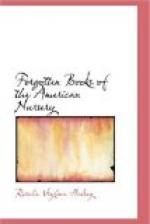This is the simple explanation as to why Eliza Leslie’s books met with so generous a reception: they were full of the incidents which children love, and unusually free from the affectations of the pious fictitious heroine.
The stories of Miss Catharine Sedgwick also received most favorable criticism, and in point of style were certainly better than Miss Leslie’s. Her reputation as a literary woman was more than national, and “Redwood,” one of her best novels, was attributed in France to Fenimore Cooper, when it appeared anonymously in eighteen hundred and twenty-four. Miss Sedgwick’s novels, however, pass out of nursery comprehension in the first chapters, although these were full of a healthy New England atmosphere, with coasting parties and picnics, Indians and gypsies, nowhere else better described. The same tone pervades her contributions to the “Juvenile Miscellany,” the “Token,” and the “Youth’s Keepsake,” together with her best-known children’s books, “Stories for Children,” “A Well Spent Hour,” and “A Love Token for Children.”
In contrast to Mrs. Sherwood’s still popular “Fairchild Family,” Catharine Sedgwick’s stories breathe a sunny, invigorating atmosphere, abounding in local incidents, and vigorous in delineation of types then plentiful in New England. “She has fallen,” wrote one admirer, most truthfully, in the “North American Review” of 1827,—“she has fallen upon the view, from which the treasures of our future literature are to be wrought. A literature to have real freshness must be moulded by the influences of the society where it had its origin. Letters thrive, when they are at home in the soil. Miss Sedgwick’s imaginations have such vigor and bloom because they are not exotics.” Another reviewer, aroused by English criticism of the social life in America, and full of the much vaunted theory that “all men are equal,” rejoiced in the author’s attitude towards the so-called “help” in New England families in contrast to Miss More’s portrayal of the English child’s condescension towards inferiors, which he thought unsuitable to set before the children in America.
All Miss Sedgwick’s stories were the product of her own keen intelligence and observation, and not written in imitation of Miss More, Miss Edgeworth, or Mrs. Sherwood, as were the anonymous tales of “Little Lucy; or, the Pleasant Day,” or “Little Helen; a Day in the Life of a Naughty Girl.” They preached, indeed, at length, but the preaching could be skipped by interested readers, and unlike the work of many contemporaries, there was always a thread to take up.
Mrs. Lydia H. Sigourney, another favorite contributor to magazines, collected her “Poetry for Children” into a volume bearing this title, in eighteen hundred and thirty-four, and published “Tales and Essays” in the same year. These were followed two years later by “Olive Buds,” and thereafter at intervals she brought out several other books, none of which have now any interest except as examples of juvenile literature that had once a decided vogue and could safely be bought for the Sunday-school library.




